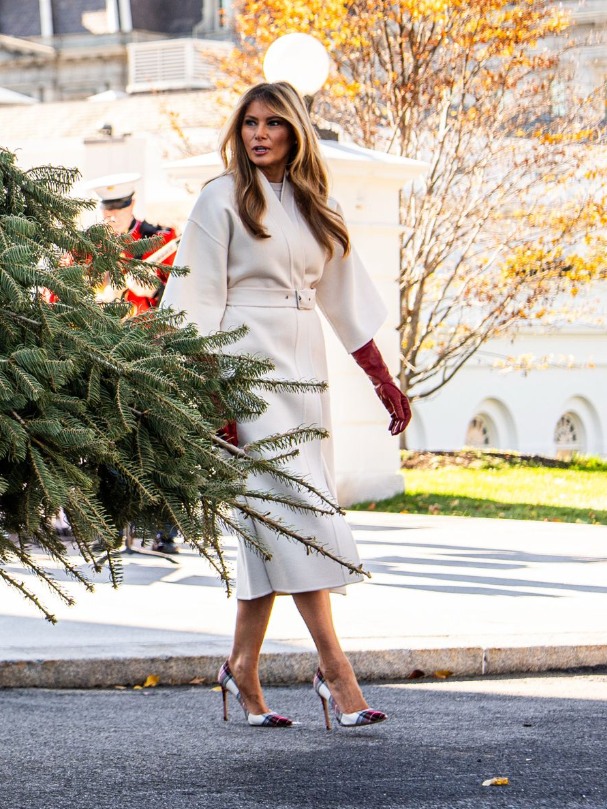The moment she stepped out of the car, everything changed. It was as if time itself had shifted, pausing to acknowledge the return of a familiar figure. Cameras clicked relentlessly, capturing each movement, each expression, each subtle gesture. Horses snorted and stamped their hooves, their breaths visible in the crisp December air, as the towering Fraser fir was slowly guided toward the North Portico. The scene felt almost cinematic, as though it had been lifted from another era—a quieter, more deliberate time when symbolism and ceremony held the nation’s attention. Melania Trump’s return to the White House that day was not just about Christmas. It was about memory, about power, about the invisible threads that bind the nation to its past, and about who still claims the heart of American tradition in a country divided by politics and ideology.
She stood in the cold Washington air, her tailored winter coat hugging her figure, exuding both elegance and an unspoken authority. She greeted the horse-drawn carriage with the ease of someone who had once known every detail of its rhythm, every sound of the bells, every careful step of the animals. Time may have passed, yet in that instant she seemed suspended in it, familiar and commanding, a figure who bridges what was with what is. The Fraser fir, freshly cut from a farm in North Carolina, was more than a tree—it was a living emblem. Rooted elsewhere, nurtured far from the White House grounds, it had been chosen to stand at the symbolic heart of American power, a reminder that tradition, like the tree, can be transplanted, shaped, and yet still endure. Melania’s words about unity, hope, and the beauty of the season carried a quiet weight, suggesting a country still grappling with itself, still seeking moments of shared reflection amid the constant noise of division.
Inside, the Blue Room awaited its transformation. Staff moved with meticulous care, layering ribbons, lights, and ornaments one after another, each choice deliberate, each placement a nod to generations of American craftsmanship and family tradition. The yet-unrevealed theme added an air of suspense, a whisper of curiosity that reminded the world that ritual often carries more power than politics. The process itself was a performance, a meditation on endurance and continuity: as the lights were strung, as the ornaments found their place, as garlands were draped with gentle precision, the room came alive with warmth and familiarity. In that moment, the tree became more than decoration; it became a statement that some rituals transcend the ebb and flow of administrations, that certain symbols can hold a nation’s attention even in turbulent times.
As the final lights flickered on and the scent of pine filled the air, the Fraser fir stood proudly, a sentinel at the center of the White House, reminding all who gazed upon it that for one brief moment, the nation could pause. Pause to reflect, pause to remember, pause to be reminded that tradition has a power that can outlast politics, that rituals can unite even when opinions diverge, and that the symbols we honor carry stories of continuity, identity, and shared history. Melania Trump’s Christmas return was more than a holiday gesture; it was a quiet reaffirmation that, amid the flux of modern America, some things—hope, beauty, memory—remain steadfast, waiting for all to look up and take notice.
